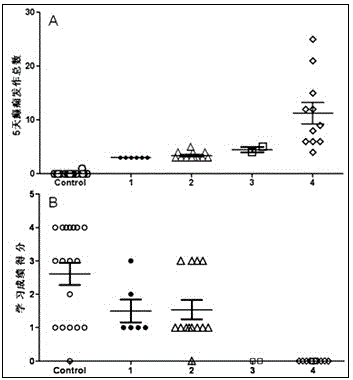Application of composition to the preparation of antiepileptic drug
A technology of antiepileptic drugs and compositions, which is applied in the field of medicine, can solve the problems of not being able to know the changes of drug effects, and achieve the effect of prolonging the residence time
- Summary
- Abstract
- Description
- Claims
- Application Information
AI Technical Summary
Problems solved by technology
Method used
Image
Examples
Embodiment 1
[0051] Example 1: Pharmacodynamic advantages and limitations of 1,6-diphosphate fructose sodium salt in chronic epilepsy model
[0052] 1. Preparation of spontaneous chronic epilepsy model:
[0053] Temporal lobe epilepsy is the most common type of epilepsy in clinical adults, and drug resistance often occurs. The rat temporal lobe epilepsy model induced by pilocarpine can simulate the symptoms, neuropathology and histomorphological changes of human temporal lobe epilepsy, so this model is widely used at home and abroad to predict the efficacy of antiepileptic drugs and study the antiepileptic mechanism.
[0054] Adult male Sprague Dawley rats (180-200g) were injected intraperitoneally with pilocarpine (300mg / kg) to induce acute seizures, and the degree of seizures was judged according to the Racine standard: Level 1: moving whiskers and chewing; Level 2: rhythmic nodding; Level 3 : One side forelimb clonus; Grade 4: standing with double forelimb clonus; Grade 5: Grade 4...
Embodiment 2
[0068] Example 2: Establishment of a method for measuring fructose 1,6-diphosphate levels in mouse blood and brain tissue
[0069] According to the method reported in the literature [Xu K et al. Pharmacological research 2008; 57: 234-8], the determination of exogenous or endogenous FBP content can be determined by enzymatic method of nicotinamide adenine dinucleotide (NADH )to fulfill. The reaction principle is as follows:
[0070]
[0071] Briefly, FBP in aldolase (aldolase, 45units mg -1 dilute 1:27with distilled water) to decompose into dihydroxyacetone phosphate (dihydroxycetone phosphate, DAP) and 3-phosphate-D-glycerol (d-glyceraldehyde 3-phosphate, GAP), and consume NADH. DAP and GAP in triosephosphate isomerase (triosephosphate isomerase, TIM: 5290 units mg -1 diluted 1:120with distilled water) can be converted to each other under the action of phosphate dehydrogenase (Glycerol-3-phosphate dehydrogenase, GDH: 252units mg -1 dilute 1:100with distilled water)...
Embodiment 3
[0085] Example 3 : Changes of 1,6-diphosphate fructose content in blood and brain tissue after intragastric administration of 1,6-diphosphate fructose sodium salt
[0086] 2.1 one dose
[0087] The normal male mice were divided into random groups (5 groups), 7 mice in each group, administered once, including the control group and the administration group. The concentrations of the administration groups were: 200 mg / kg, 300 mg / kg, 500 mg / kg, 1000 mg / kg. The animals in the control group were given the same amount of normal saline. After intragastric administration for 2 hours, the concentration of FBP in blood and brain tissue was measured by the method established above. Research data show that the FBP content in the blood is the highest when given 200 mg / kg of FBP, which is 4 times the basal value of endogenous FBP, and when the dose is ≥ 400 mg / kg, the FBP in the blood is only about higher than the basal value ( Figure 7 ), this paradox may be because high-dose FBP ...
PUM
 Login to View More
Login to View More Abstract
Description
Claims
Application Information
 Login to View More
Login to View More - R&D
- Intellectual Property
- Life Sciences
- Materials
- Tech Scout
- Unparalleled Data Quality
- Higher Quality Content
- 60% Fewer Hallucinations
Browse by: Latest US Patents, China's latest patents, Technical Efficacy Thesaurus, Application Domain, Technology Topic, Popular Technical Reports.
© 2025 PatSnap. All rights reserved.Legal|Privacy policy|Modern Slavery Act Transparency Statement|Sitemap|About US| Contact US: help@patsnap.com



